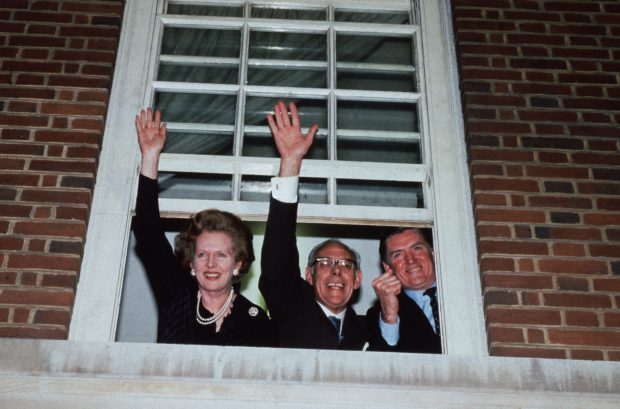This is a strange book. Peter Stothard, the editor of the TLS, is packing up his office. It is a year after Margaret Thatcher’s death, and Murdoch’s Wapping site is being destroyed to make way for new, expensive flats. As the national memory of Thatcher fades, and transmutes into myth and caricature, so the physical scene of one of the seminal battles of her time, where the old print unions and their rackets were destroyed, crumbles into dust.
Into his room comes Miss R, a young and mysterious historian, to interview him for her thesis about Thatcher’s courtiers. The effect is dreamlike: partly a sort of Cherry Orchard, with Stothard playing Firs the butler and the buildings which had housed the old Murdoch papers standing in for the trees; partly a mystery (‘Who is the girl?’); and partly a meditation on the nature of courtiers at a court with a dominant ruler. It turns out that the courtiers whom the mysterious Miss R is researching were all pupils of Stothard — a serious classicist as well as a fine editor — whom he gathered once a week in a Wapping pub to study the life and works of Seneca the Younger, the tutor of, principal adviser to and finally victim of the Emperor Nero.
If this all seems unlikely, it is as nothing to the oddity of the four who gathered for these tutorials: David Hart, the Old Etonian inheritor of two fortunes (one of which he lost) from the Ansbacher merchant bank; Woodrow Wyatt, once the scourge of ballot-rigging communists in the Electrical Trades Union, latterly courtier to many of the rich and powerful (Arnold Weinstock paid off his debts at least once) but above all to Thatcher and Murdoch; Sir Ronnie Millar, speechwriter and joke-smith to Heath and Thatcher (‘The lady’s not for turning’); and, finally, Frank Johnson, pre-eminent parliamentary sketchwriter and fine journalist who perhaps more faithfully than anyone carried Thatcher’s torch even — especially — into the dying days of her regime.
A more ill-assorted tutorial group it would be hard to imagine. Johnson and Millar were both, in their different ways, among nature’s gentlemen. Hart and Wyatt, to put it mildly, were not. I regarded Hart’s temporary penetration of the Thatcher court, and then his return to the fringes of power under Rifkind and Portillo, as evidence that even intelligent politicians can be idiots when it comes to choosing their friends. But then, I had known him a little longer than they had, and extraordinary people could be charmed by him: Stothard’s account of Edward Teller and Vladimir Bukovsky talking about Reagan’s Star Wars project in Hart’s ‘Peace Garden’ while Ronnie Millar puts them right about the science is beyond comic. Hart, in his later manifestations, was searching for his pseudo-Thatcher, just as people in the Roman empire searched after his death for a pseudo-Nero. Both searches failed.
Wyatt — the ‘Voice of Reason’ in the News of the World — was a more conventional courtier, who deserved credit for a brave war and for taking on the kind of people in the ETU who are now back in fashion in the Labour Party.
Ronnie Millar and Frank Johnson were different. They were not, like the other two, rogues loveable or, as I think, not loveable. Both of them were genuinely devoted to Thatcher, Millar for reasons of personal affection, Johnson from philosophical commitment. Stothard, as Times editor, used them all as sources, but also compared and contrasted them with his classicist’s eye to minor figures in Suetonius or Tacitus, sometimes a little naively, but with a historian’s objectivity. Somehow this makes the gossip he reports acceptable: timeless and sometimes very funny, although it would be comforting to be able to say to oneself, ‘thank goodness this sort of Roman imperial sycophancy cannot happen in 20th-century Britain’.
But of course, one cannot say that. Whatever it does to those who hold it, power always corrupts the smaller people who gather around it. Stothard flattered his pupils when he chose to teach them about Seneca (he picked the Loeb editions out of the skips into which the old library of the Times was being deposited). Seneca was a top-of-the-second-rank writer and thinker, who amassed more money than Hart or Wyatt ever managed, and survived for years in a court as dangerous as any in history.
None of Stothard’s Senecans was in that class. But it’s a conceit which enables him elegantly to frame some remarkable anecdotes about the Thatcher years and to ruminate wisely about the nature of power. It also allows him to write a little about himself in an elegiac way, by means of the slightly annoying medium of the enigmatic Miss R — who (spoiler alert) turns out to be the granddaughter of the man who introduced him to Seneca as a child. And the complicated structure just about works. Whether Miss R is real or a fantasy, I do not know. But do not let her put you off this strange but delightful book.






Comments